| Fort Frederica National Monument | |
|---|---|
  | |
| Location | St. Simons Island, Georgia, USA |
| Nearest city | Brunswick, Georgia |
| Coordinates | 31°13′26″N 81°23′36″W / 31.22384°N 81.39324°W / 31.22384; -81.39324 |
| Area | 284.49 acres (115.13 ha) |
| Authorized | May 26, 1936 (1936-May-26) |
| Visitors | 293,041 (in 2011) |
| Governing body | National Park Service |
| Website | Fort Frederica National Monument |
| U.S. National Register of Historic Places | |
| U.S. Historic district | |
 Fort Frederica in 2020 Fort Frederica in 2020 | |
| Nearest city | Brunswick, Georgia |
| Area | 218 acres (88.2 ha) |
| Built | 1736 (1736) |
| NRHP reference No. | 66000065 (original) 100005351 (increase) |
| Significant dates | |
| Added to NRHP | October 15, 1966 |
| Boundary increase | July 23, 2020 |
Fort Frederica National Monument, on St. Simons Island, Georgia, preserves the archaeological remnants of a fort and town built by James Oglethorpe between 1736 and 1748 to protect the southern boundary of the British colony of Georgia from Spanish raids. About 630 British troops were stationed at the fort.
A town of up to 1,000 colonial residents had grown up outside the fort; it was laid out following principles of the Oglethorpe Plan for towns in the Georgia Colony. The town was named Frederica, after Frederick, Prince of Wales, son of King George II. The monument was listed on the National Register of Historic Places on October 15, 1966.
History
In the early 18th century, Europeans called the land lying between British South Carolina and Spanish Florida the "Debatable Land". Today's state of Georgia was then the center of a centuries-old imperial conflict between Spain and Britain. After the philanthropist James Oglethorpe founded the colony of Georgia in 1733, to provide a place where poor debtors could settle, colonists from England and Scotland, and refugees from the German Electorate of the Palatinate built Fort Frederica in 1736 to defend their new territory. They named Frederica for Frederick, Prince of Wales, (1707–1751). The name was feminized to distinguish it from Fort Frederick in South Carolina.
In the 1742 battles of Bloody Marsh and Gully Hole Creek, forces under Oglethorpe successfully repulsed Spanish attempts to invade St. Simons Island. Afterward the Spanish no longer threatened the colony; in 1749 the government disbanded the garrison at Frederica. Soon the village fell into economic decline, and by 1755 it was mostly abandoned. The town survived a fire in 1758, but after a few more years, it was abandoned. Naturalist William Bartram visited the site in March, 1774. Though it was in ruins he noted that there was still a small garrison there.
Fort Frederica was documented and authorized as a National Monument on May 26, 1936, under the Franklin D. Roosevelt administration during the Great Depression. During this period, the Works Progress Administration (WPA) sponsored numerous surveys of historic areas and buildings across the country to identify, document and protect the resources for the future, as well as to provide employment.
Starting in 1947, the National Park Service and the Ft. Frederica Association, a citizens' interest group, sponsored a series of archaeological investigations at the Frederica site. Using information from 18th-century maps and journals as guides, the archaeologists excavated sections of the fort and village. By correlating the archaeological data with the historic documents and excavating remains of structures, the archaeologists have provided important insight into Frederica's past and colonial history, a complex time of international rivalries.
As a historic area under the National Park Service, the National Monument was listed on the National Register of Historic Places on October 15, 1966. Fort Frederica is open to the public and admission is free.

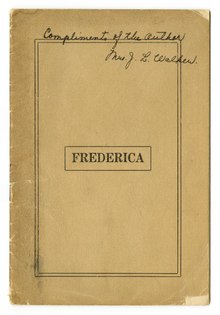
Gallery
-
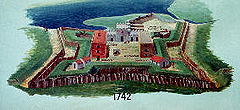 Historical layout of the colonial fort
Historical layout of the colonial fort
-
 The magazine of Fort Frederica
The magazine of Fort Frederica
-
 Fort Frederica on riverfront
Fort Frederica on riverfront
-
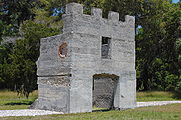 Remains of Fort Frederica barracks
Remains of Fort Frederica barracks
-
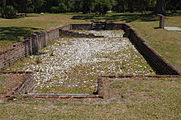 Remains of Frederica house
Remains of Frederica house
-
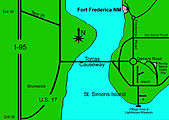 Modern map of the area
Modern map of the area
-
 Historical layout of the town
Historical layout of the town
Related sites
- Fort Argyle
- Battle of Bloody Marsh
- Battle of Gully Hole Creek
- Castillo de San Marcos National Monument
- Fort Caroline National Memorial
- Fort King George
- Fort Matanzas National Monument
- Fort Morris State Historic Site
- Wormsloe Historic Site
- Oglethorpe Plan
- List of national monuments of the United States
Footnotes
- "Listing of acreage – December 31, 2011" (XLSX). Land Resource Division, National Park Service. Retrieved 2012-05-13. (National Park Service Acreage Reports)
- "NPS Annual Recreation Visits Report". National Park Service. Retrieved 2012-05-13.
- "National Register Information System". National Register of Historic Places. National Park Service. July 9, 2010.
- para.5, Testimony of NPS Deputy Director A.Durand Jones regarding HR. 1113. Archived 2008-10-05 at the Wayback Machine, Dept. of Interior, 2004, accessed 3 Sept 2008
- https://www.nps.gov/fofr/index.htm#:~:text=Fort%20Frederica%20illustrates%20the%20story,people%20that%20once%20lived%20here.
- para.6 Archived 2008-10-05 at the Wayback Machine, Dept. of Interior
- T. B. BARTOW The Georgia Historical Quarterly Vol. 1, No. 4 (DECEMBER, 1917), pp. 347-349
- para.7 Archived 2008-10-05 at the Wayback Machine
References
- The National Parks: Index 2001–2003. Washington: U.S. Department of the Interior.
External links
- Official NPS website: Fort Frederica National Monument
- Archeology at Fort Frederica National Monument
- "Frederica: An 18th-Century Planned Community", a National Park Service Teaching with Historic Places (TwHP) lesson plan
- Fort Frederica historical marker
 Media related to Fort Frederica National Monument at Wikimedia Commons
Media related to Fort Frederica National Monument at Wikimedia Commons
| National monuments of the United States | |
|---|---|
| National Park Service |
|
| US Forest Service |
|
| Bureau of Land Management |
|
| Other (FWS, DOE, AFRH, NOAA, USAF, Army) |
|
| Full Detailed List | |
- Government buildings completed in 1748
- Military installations established in 1748
- Archaeological sites in Georgia (U.S. state)
- Forts in Georgia (U.S. state)
- National Park Service national monuments in Georgia (U.S. state)
- History of the Thirteen Colonies
- Military and war museums in Georgia (U.S. state)
- Museums in Glynn County, Georgia
- Archaeological museums in Georgia (U.S. state)
- Protected areas established in 1936
- British forts in the United States
- Colonial forts in Georgia (U.S. state)
- Protected areas of Glynn County, Georgia
- Forts on the National Register of Historic Places in Georgia (U.S. state)
- 1736 establishments in the Thirteen Colonies
- Historic districts on the National Register of Historic Places in Georgia (U.S. state)
- National Register of Historic Places in Glynn County, Georgia
- Former county seats in Georgia (U.S. state)
- St. Simons, Georgia